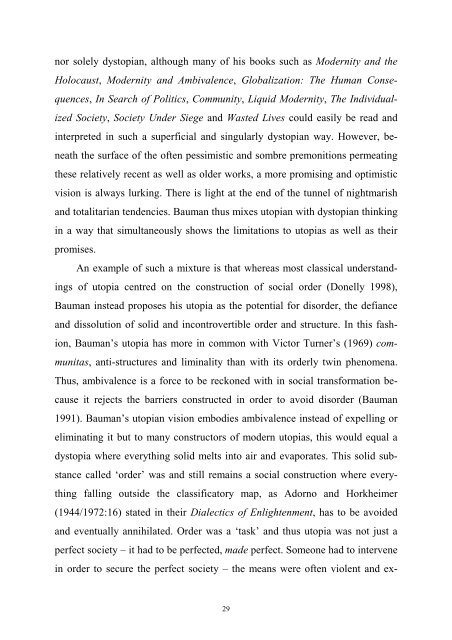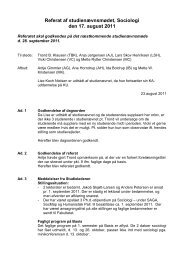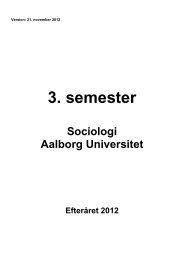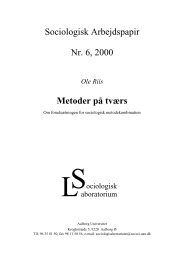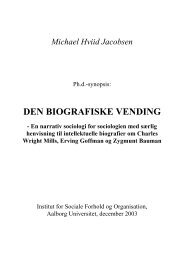Utopianism in the Work of Zygmunt Bauman - Sociologi - Aalborg ...
Utopianism in the Work of Zygmunt Bauman - Sociologi - Aalborg ...
Utopianism in the Work of Zygmunt Bauman - Sociologi - Aalborg ...
You also want an ePaper? Increase the reach of your titles
YUMPU automatically turns print PDFs into web optimized ePapers that Google loves.
nor solely dystopian, although many <strong>of</strong> his books such as Modernity and <strong>the</strong><br />
Holocaust, Modernity and Ambivalence, Globalization: The Human Conse-<br />
quences, In Search <strong>of</strong> Politics, Community, Liquid Modernity, The Individual-<br />
ized Society, Society Under Siege and Wasted Lives could easily be read and<br />
<strong>in</strong>terpreted <strong>in</strong> such a superficial and s<strong>in</strong>gularly dystopian way. However, be-<br />
neath <strong>the</strong> surface <strong>of</strong> <strong>the</strong> <strong>of</strong>ten pessimistic and sombre premonitions permeat<strong>in</strong>g<br />
<strong>the</strong>se relatively recent as well as older works, a more promis<strong>in</strong>g and optimistic<br />
vision is always lurk<strong>in</strong>g. There is light at <strong>the</strong> end <strong>of</strong> <strong>the</strong> tunnel <strong>of</strong> nightmarish<br />
and totalitarian tendencies. <strong>Bauman</strong> thus mixes utopian with dystopian th<strong>in</strong>k<strong>in</strong>g<br />
<strong>in</strong> a way that simultaneously shows <strong>the</strong> limitations to utopias as well as <strong>the</strong>ir<br />
promises.<br />
An example <strong>of</strong> such a mixture is that whereas most classical understand-<br />
<strong>in</strong>gs <strong>of</strong> utopia centred on <strong>the</strong> construction <strong>of</strong> social order (Donelly 1998),<br />
<strong>Bauman</strong> <strong>in</strong>stead proposes his utopia as <strong>the</strong> potential for disorder, <strong>the</strong> defiance<br />
and dissolution <strong>of</strong> solid and <strong>in</strong>controvertible order and structure. In this fash-<br />
ion, <strong>Bauman</strong>’s utopia has more <strong>in</strong> common with Victor Turner’s (1969) com-<br />
munitas, anti-structures and lim<strong>in</strong>ality than with its orderly tw<strong>in</strong> phenomena.<br />
Thus, ambivalence is a force to be reckoned with <strong>in</strong> social transformation be-<br />
cause it rejects <strong>the</strong> barriers constructed <strong>in</strong> order to avoid disorder (<strong>Bauman</strong><br />
1991). <strong>Bauman</strong>’s utopian vision embodies ambivalence <strong>in</strong>stead <strong>of</strong> expell<strong>in</strong>g or<br />
elim<strong>in</strong>at<strong>in</strong>g it but to many constructors <strong>of</strong> modern utopias, this would equal a<br />
dystopia where everyth<strong>in</strong>g solid melts <strong>in</strong>to air and evaporates. This solid sub-<br />
stance called ‘order’ was and still rema<strong>in</strong>s a social construction where every-<br />
th<strong>in</strong>g fall<strong>in</strong>g outside <strong>the</strong> classificatory map, as Adorno and Horkheimer<br />
(1944/1972:16) stated <strong>in</strong> <strong>the</strong>ir Dialectics <strong>of</strong> Enlightenment, has to be avoided<br />
and eventually annihilated. Order was a ‘task’ and thus utopia was not just a<br />
perfect society – it had to be perfected, made perfect. Someone had to <strong>in</strong>tervene<br />
<strong>in</strong> order to secure <strong>the</strong> perfect society – <strong>the</strong> means were <strong>of</strong>ten violent and ex-<br />
29


